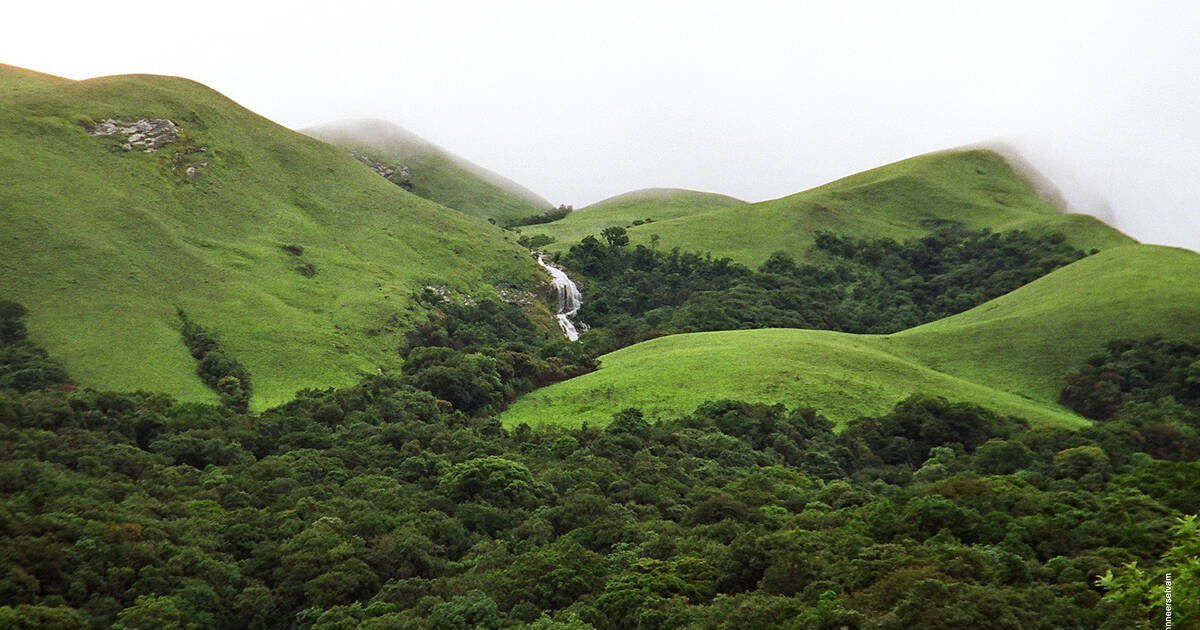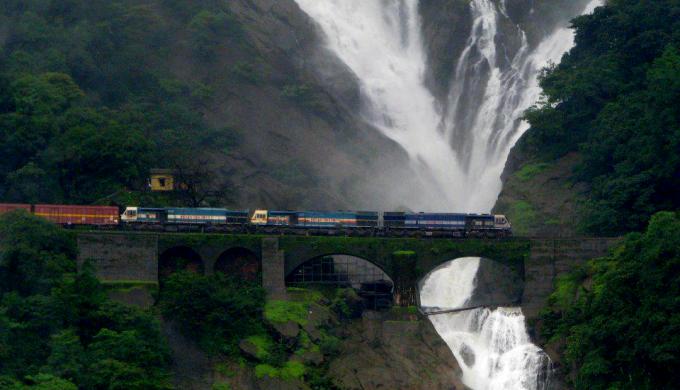The Western Ghats is a mountain range located along the western coast of India, stretching over 1,600 km from Gujarat in the north to Tamil Nadu in the south. The range is home to a diverse array of flora and fauna, as well as numerous indigenous communities, and has been recognized as a UNESCO World Heritage Site due to its outstanding natural and cultural value.The history of the Western Ghats dates back thousands of years, with evidence of human habitation in the region dating back to the Neolithic period. The range has long been an important center of trade and commerce, with many ancient trade routes and pilgrimage trails passing through the region.Over the centuries, the Western Ghats has also played an important role in the region's cultural and religious history, serving as a center for the development of Hinduism, Buddhism, and Jainism. The range is home to numerous ancient temples and sacred sites, many of which are still in use today.In more recent history, the Western Ghats has been the site of significant ecological and conservation efforts. In the 19th and 20th centuries, the range was heavily exploited for its natural resources, leading to deforestation, soil erosion, and loss of biodiversity.In response to these threats, conservation efforts were launched to protect the region's unique ecosystem and promote sustainable development. Today, the Western Ghats is home to numerous protected areas, including national parks and wildlife sanctuaries, and is recognized as one of the most important biodiversity hotspots in the world.In addition to its ecological and cultural value, the Western Ghats is also an important source of livelihood for millions of people who live in the region. The range is home to numerous indigenous communities who have long relied on the forest for their subsistence, and who continue to practice traditional forms of agriculture and natural resource management.The Western Ghats is known for its rich and unique biodiversity, with a high level of endemism, or species found nowhere else in the world. The range is home to over 7,000 species of flowering plants, 139 mammal species, 508 bird species, 179 amphibian species, and 290 freshwater fish species, among others. Many of these species are threatened or endangered due to habitat loss, hunting, and other human activities.The Western Ghats is also an important source of freshwater for much of southern India, with numerous rivers and streams originating in the range. The range's forests and wetlands help to regulate the region's water cycle and prevent soil erosion, making it an important ecological resource.In recognition of its ecological and cultural value, the Western Ghats was declared a UNESCO World Heritage Site in 2012. The site encompasses 39 individual properties, including national parks, wildlife sanctuaries, and protected areas, as well as numerous sacred sites and cultural landmarks.Today, the Western Ghats faces a number of threats, including deforestation, habitat fragmentation, and the impacts of climate change. Efforts are underway to promote sustainable development and conservation in the region, including the restoration of degraded habitats, the protection of key species and ecosystems, and the promotion of sustainable agriculture and natural resource management practices.The Western Ghats is also home to numerous indigenous communities who have inhabited the region for thousands of years. These communities have developed a deep knowledge of the region's ecology and natural resources, and have traditionally practiced sustainable forms of agriculture and natural resource management.Many of these communities continue to face numerous challenges, including land rights issues, loss of traditional knowledge and practices, and the impacts of development projects. Efforts are underway to support the rights and livelihoods of these communities, including initiatives to promote sustainable livelihoods and strengthen local governance.The Western Ghats is also an important center of cultural and religious heritage, with numerous ancient temples, sacred sites, and pilgrimage routes located throughout the range. Many of these sites have been in use for thousands of years and continue to attract large numbers of visitors.Overall, the Western Ghats is a unique and valuable ecosystem that supports a diverse array of life and provides numerous ecological, cultural, and economic benefits to the region. However, the range faces numerous challenges, and it will be important to continue to promote sustainable development and conservation efforts in order to ensure the long-term health and wellbeing of this important region.
Western Ghats
World Heritage History
February 23, 2023
The Western Ghats is a mountain range located along the western coast of India, stretching over 1,600 km from Gujarat in the north to Tamil Nadu in the south. The range is home to a diverse array of flora and fauna, as well as numerous indigenous communities, and has been recognized as a UNESCO World Heritage Site due to its outstanding natural and cultural value.The history of the Western Ghats dates back thousands of years, with evidence of human habitation in the region dating back to the Neolithic period. The range has long been an important center of trade and commerce, with many ancient trade routes and pilgrimage trails passing through the region.Over the centuries, the Western Ghats has also played an important role in the region's cultural and religious history, serving as a center for the development of Hinduism, Buddhism, and Jainism. The range is home to numerous ancient temples and sacred sites, many of which are still in use today.In more recent history, the Western Ghats has been the site of significant ecological and conservation efforts. In the 19th and 20th centuries, the range was heavily exploited for its natural resources, leading to deforestation, soil erosion, and loss of biodiversity.In response to these threats, conservation efforts were launched to protect the region's unique ecosystem and promote sustainable development. Today, the Western Ghats is home to numerous protected areas, including national parks and wildlife sanctuaries, and is recognized as one of the most important biodiversity hotspots in the world.In addition to its ecological and cultural value, the Western Ghats is also an important source of livelihood for millions of people who live in the region. The range is home to numerous indigenous communities who have long relied on the forest for their subsistence, and who continue to practice traditional forms of agriculture and natural resource management.The Western Ghats is known for its rich and unique biodiversity, with a high level of endemism, or species found nowhere else in the world. The range is home to over 7,000 species of flowering plants, 139 mammal species, 508 bird species, 179 amphibian species, and 290 freshwater fish species, among others. Many of these species are threatened or endangered due to habitat loss, hunting, and other human activities.The Western Ghats is also an important source of freshwater for much of southern India, with numerous rivers and streams originating in the range. The range's forests and wetlands help to regulate the region's water cycle and prevent soil erosion, making it an important ecological resource.In recognition of its ecological and cultural value, the Western Ghats was declared a UNESCO World Heritage Site in 2012. The site encompasses 39 individual properties, including national parks, wildlife sanctuaries, and protected areas, as well as numerous sacred sites and cultural landmarks.Today, the Western Ghats faces a number of threats, including deforestation, habitat fragmentation, and the impacts of climate change. Efforts are underway to promote sustainable development and conservation in the region, including the restoration of degraded habitats, the protection of key species and ecosystems, and the promotion of sustainable agriculture and natural resource management practices.The Western Ghats is also home to numerous indigenous communities who have inhabited the region for thousands of years. These communities have developed a deep knowledge of the region's ecology and natural resources, and have traditionally practiced sustainable forms of agriculture and natural resource management.Many of these communities continue to face numerous challenges, including land rights issues, loss of traditional knowledge and practices, and the impacts of development projects. Efforts are underway to support the rights and livelihoods of these communities, including initiatives to promote sustainable livelihoods and strengthen local governance.The Western Ghats is also an important center of cultural and religious heritage, with numerous ancient temples, sacred sites, and pilgrimage routes located throughout the range. Many of these sites have been in use for thousands of years and continue to attract large numbers of visitors.Overall, the Western Ghats is a unique and valuable ecosystem that supports a diverse array of life and provides numerous ecological, cultural, and economic benefits to the region. However, the range faces numerous challenges, and it will be important to continue to promote sustainable development and conservation efforts in order to ensure the long-term health and wellbeing of this important region.
Followers
Labels
- Abu Mena 1
- Ajanta Caves 10
- Bahrain Pearling Trail 1
- BLOG 2
- Casbah of Algiers 1
- Chichén Itzá 1
- Dilmun Burial Mounds 1
- Djémila 1
- Giza pyramid complex. 1
- Great Barrier Reef 2
- Great Living Chola Temples 8
- International Campaign to Save the Monuments of Nubia 1
- Islamic Cairo 1
- Keoladeo National Park 5
- Machu Picchu 9
- Petra 6
- Qal'at al-Bahrain 1
- Qal'at Bani Hammad 1
- Saint Catherine's Monastery 1
- Sun Temple 7
- Sundarbans National Park 3
- Taj Mahal 11
- Tassili n'Ajjer 1
- Thebes 1
- Timgad. 1
- Tipaza. 1
- Wadi al Hitan. 1
- Western Ghats 4
- World Heritage History 12
Contact Form
Popular Posts
Djémila
February 24, 2023
Qal'at al-Bahrain
February 25, 2023
Saint Catherine's Monastery
February 27, 2023
Bahrain Pearling Trail
February 25, 2023
Islamic Cairo
February 27, 2023
Dilmun Burial Mounds
February 24, 2023
Tags

Recent Posts
3/recent/post-list
Categories
- Abu Mena 1
- Ajanta Caves 10
- Bahrain Pearling Trail 1
- BLOG 2
- Casbah of Algiers 1
- Chichén Itzá 1
- Dilmun Burial Mounds 1
- Djémila 1
- Giza pyramid complex. 1
- Great Barrier Reef 2
- Great Living Chola Temples 8
- International Campaign to Save the Monuments of Nubia 1
- Islamic Cairo 1
- Keoladeo National Park 5
- Machu Picchu 9
- Petra 6
- Qal'at al-Bahrain 1
- Qal'at Bani Hammad 1
- Saint Catherine's Monastery 1
- Sun Temple 7
- Sundarbans National Park 3
- Taj Mahal 11
- Tassili n'Ajjer 1
- Thebes 1
- Timgad. 1
- Tipaza. 1
- Wadi al Hitan. 1
- Western Ghats 4
- World Heritage History 12
Tags
Designed with by Way2Themes | Distributed by Magazine Blogger Template




0 Comments